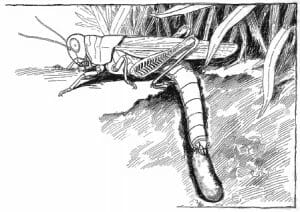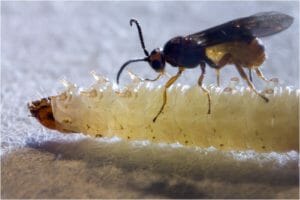Ovipositor
An ovipositor is a tube shaped organ used by insects and most fish to deposit eggs.
The morphology of the ovipositor varies from species to species. It may be long, short, wide or needle thin; in insects it is usually composed of the hardened sclerites of the exoskeleton. Often it is concealed within the body and protracted for use, although sometimes the ovipositor is permanently extended outside of the body.

The image shows the abdomen of a cricket. The upward pointing spike structure is the ovipositor.
Function of Ovipositor
Egg Depositing
The primary function of the ovipositor in the majority of insects and fish is to release mature eggs from inside of the female body.
Immature eggs, known as oocytes, develop from specialized stem cells within a part of the ovary called the germarium. The oocytes are then transported down through tapered structures within the ovary called ovarioles. At this point, the oocytes are surrounded by a layer of follicle cells, which enable the transport of substances from the hemolymph (the equivalent to blood in most invertebrates) into the oocyte cytoplasm.
When the oocytes are passed further down the ovarioles, the follicle cells go on to synthesize the chorion (the eggshell), which provides waterproofing and protection once the egg has been laid. Now lacking in follicle cells, the egg is free to move into the oviduct in a process called ovulation.
Ovulation is only initiated once the eggs have matured within the ovariole and the brain receives the physical stimulus associated with mating.
Once mating and fertilization, has occurred, muscle contractions facilitate the movement of eggs downward through the oviduct. They are then passed into the ovipositor, allowing the controlled placement of the eggs into a suitable environment. As the eggs are released, glands, called ‘accessory glands’ produce a cement-like substance, which attaches the eggs to each other and also to the substrate where they are laid.
The females must select an oviposition site that maximizes the survival chance of her offspring, considering factors such as food available to the larvae and chance of attack from predators. They can perform this selection using olfactory (smell) cues or visual cues based on the shape, size or spectral quality of a potential oviposition site.
Digging
Many insects use their ovipositor as a tool, which allows them to excavate through a substrate and deposit their eggs in a suitable and safe place.
A notable example is the ovipositor of a grasshopper. Extending beyond the tip of the abdomen, the ovipositor is comprised of two pairs of shovel-shaped structures. One pair is located dorsally (on top) and one pair ventrally (on the bottom), These are called ‘ovipositor valves’. During oviposition, muscle contractions in the abdomen allow the valves to be opened and closed, and for the ovipositor to be pushed and pulled in and out of the tip of the abdomen.
The action of the ovipositor opening and closing causes the grasshopper to dig a deep hole in the ground; to initiate the action the grasshopper pushes the tip of the abdomen firmly into the substrate and engages the motion of the valves. The grasshopper then stands on the substrate surface as the ovipositor digs into the ground below.
Once the hole has been dug, the abdomen is retracted slightly and the opening and closing action speeds up so that the eggs are released one by one, and are dropped into the bottom of the hole, accompanied by the secretion of a frothy substance. After the deposition of each egg, the valve is closed, which reverses the orientation of the egg, ensuring that each developing offspring will hatch with its head facing upward.
Once the last egg has been laid—there are usually around 50-100 laid in each oviposition—the abdomen is retracted slowly from the hole and a final portion of the frothy substance is secreted. The froth turns dark and hardens in order to cap off the ‘egg-pod’, protecting them from desiccation and predators.

The image shows a grasshopper positioned with her ovipositor inside the tunnel where she will deposit her eggs. The shovel-shaped valves of the ovipositor have dug out the tunnel.
Piercing
Rather than laying their eggs onto a substrate, many insects insert their ovipositor directly into a host—usually either a plant or another insect.
Once a female has located a suitable host, the ovipositor acts as a needle, penetrating the skin or exoskeleton. Often, the ovipositor will release venomous substances to paralyze the host. The paralysis is often permanent although may also be temporary, in which case the host recovers and continues feeding with the parasitic eggs inside its body. In some parasitoid species, the larvae develop within the body, selectively feeding on the internal tissues of the host. The digestive tract and nervous system are left till last so that the host remains alive as long as possible.
The ovipositors of some wasp species have jagged ridges, which allow the wasp to cut through tough plant tissue and even wood, in order to reach hosts that are concealed within. In this case the ovipositors can be exceptionally long, sometimes up to eight times the body length of the parasitoid! In order to pass the egg along this extended tube, the eggs are often very small so that they can slide along the narrow tube, expanding in size once they are inside the host body.

The image shows a parasitoid wasp (Bracon brevicornis) inserting its ovipositor into its paralyzed host, a black-headed caterpillar (Opisina arenosella).
In some insects, especially the Hymenoptera, the stinger is actually a modified ovipositor. It is likely that the ovipositor was initially used to penetrate the tissues of plants—a behavior still observable in primitive sawflies. This provided an evolved pre-adaption to the parasitism of other insects, and many modern day wasps still utilize their venomous stings for this purpose.
Further down the line, bees evolved a reversion to a diet of pollen and nectar, so no longer needed to use the sting as a weapon to paralyze other insects; furthermore, the social colony structure of a bee population means that only the queen is required to lay eggs and that females are sterile. Despite having no use for an egg-laying ovipositor, the venomous capabilities within the stinger proved beneficial as a defensive weapon, and the stinger remained functional.
Counting
Scientists have found that some species of parasitoid insects, which use their ovipositors to lay their eggs within the bodies of other insects, can also use their ovipositors to count!
Because the parasitoid offspring feed from the body tissues of the parasitized insect, it is important that they have exclusive access to the host tissues, giving them the best chance of being able to feed once hatched. If the parasitoid lays its eggs within the body of a host that has already been parasitized (a scenario called ‘superparasitism’) the competition between the larvae of the first and second parasitoid will eventually result in the death of either one.
To avoid this happening, parasitoids have evolved the ability to detect when hosts have already been parasitized and avoid laying their eggs there. Further, they have been shown to discriminate between hosts with different numbers of eggs, and are less likely to lay eggs inside hosts that have already been heavily parasitized.
This is possible due to sensory receptors at the end of their ovipositor, which are connected to the neurons of the parasitoid. If there are already eggs inside the host, the pheromones that are used to mark eggs when deposited will be detected by the sensory receptors once the ovipositor penetrates the host body. For each egg detected within the parasitized host, a neuron response is triggered, allowing the parasitoid to accurately determine the number of foreign eggs within a host.
Quiz
1. Which of the following is not a function of the ovipositor?
A. Releasing Venom
B. Producing immature eggs
C. Digging
D. Detecting pheromones
2. Which of the following statements is true?
A. Only females have ovipositors
B. All ovipositors look the same
C. All ovipositors produce eggs
D. All ovipositors contain venom
References
- Godfray, H. C. J. Parasitoid Natural History. (1994) In: Parasitoids: Behavioural and Evolutionary Ecology. Princeton University Press. Chichester, West Sussex.
- Jans, N. (2002) Evolutionary ecology of oviposition strategies. Pp349-376. In M.Hilker, & T. Meiners (Eds), Chemoecology of insect eggs and egg deposition. Blackwell, Berlin.
- Joeballenger2005 (2015) Why can’t male bees (or wasps) sting? Ask an entomologist. Retrieved from: https://askentomologists.com/2015/09/23/why-cant-male-bees-or-wasps-sting/
- Parasitic Wasps (2016) Kansas State University. Department of Entomology. Retrieved from: http://entomology.k-state.edu/extension/insect-information/beneficial-organisms/parasitoids.html
